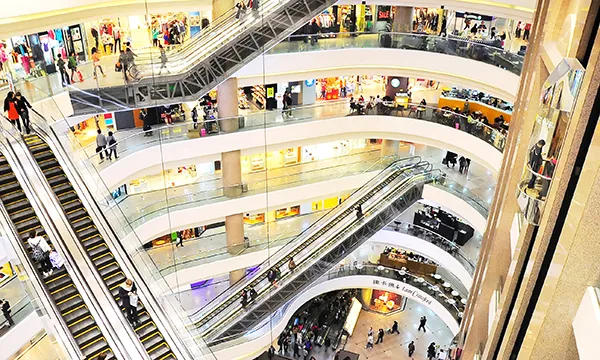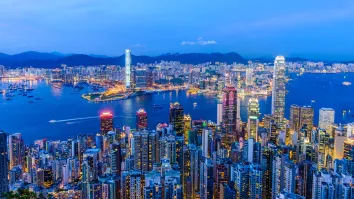
The changing face of Hong Kong's retail
Retailers should be ready to revamp their stores into unique lifestyle concepts to battle e-commerce.
An upgraded mall shopping experience will be crucial for retailers that want to combat the rise of online shopping. Aggressive mainland Chinese firms such as JD.com and Alibaba Group are courting high-end shoppers with new online retail sites stocked with luxury goods, which they previously could only obtain by travelling to Hong Kong or other countries.
Chinese consumers accounting for nearly a third of global luxury spending and a change in habit to high-ticket shopping at home will have an impact on Hong Kong luxury retailers. Joe Lin, executive director (advisory and transactions services) at CBRE Hong Kong forecasts that luxury items will be more focused on quantity sales than the price value in the coming year. “Chinese tourist numbers rebounded in recent quarters, and shopping still ranks high in their agenda.
However, they are shifting to more mid-range products and buying less in quantity, as the gifting culture has been greatly diminished,” he said. “Although we are seeing the sales value of jewellery items rebound in the last couple of months because of the low-base effect year-on-year, but in longer term its momentum may not be as strong as the last decade.”
Cynthia Ng, director at Colliers Hong Kong, expects tourism numbers to improve mildly but does not foresee a jump, owing to a slew of factors that has diminished retail demand and will require a complex solution. “The market slump in [the] past few years was not triggered by a single incident or a financial crisis but simply the policy of anti-corruption, political relationship with China, and a lack of confidence or clarity towards the government bodies in Hong Kong,” she said. “Such confidence could only be gradually picked up, [rather] than overnight.”
Alicia Garcia-Herrero, chief economist at Natixis forecasts tourism numbers to continue to increase, but at a more moderate level unlike previous years. She noted that visitors from other countries are also growing, such as Japan and Korea, representing a small but improving diversification of tourist sources that can benefit different parts of the retail industry—and a chance for HK to reinvent its retail growth paradigm.
“Retail sales have bottomed out but still quite far from the rapid expansion period previously. This points [to] a more fundamental problem of the narrow focus in shopping, which is against the global trend is switching to higher quality tourism,” she said.
“The world is competing for tourists through improvement in experience and Hong Kong may not be able to use its old growth model forever,” she said.
2018 promises to be a year of stabilisation and significant adjustments for retailers, with a particularly promising outlook for segments like jewellery and cosmetics. Aside from convincing shops to tweak their product lineups to cater more to domestic demand, the retail transformation will also push more stores to launch unique lifestyle concepts. The idea is to add more value to the brick-and-mortar store experience and make walking through store aisles a compelling alternative to increasingly convenient online shopping. The hunt for retail space is also expected to heat up as the retail rent correction likely bottoms out.
Stable market
“In 2018, we think the market will be more stable,” CBRE Hong Kong’s Lin said. “Multi-brands cosmetic operators and jewellery are starting to look for good opportunities in the high street market; the tier-one high quality shops will be absorbed first if the rent is reduced to an attractive level which the retailers can survive with today’s retail market situation.”
He reckoned that more retailers are feeling relieved as the rental burden has eased in the past two years, with overall rent on major retail streets dropping significantly in the period. Instead of costs, the focus now is on how to generate a stronger, more diversified revenue stream—one that is more grounded on the local market to protect their businesses somewhat from the shock of low tourist numbers, as it has in recent years.
“The main concern will be how to tap for new business sources when Chinese tourists are no longer their main support,” said Lin. “We tend to believe that it is a positive recovery, especially when we have seen so many retailers change their strategies quickly to focus more on the local market or the less expensive product range for tourists. With this observation, this recovery can last long.”
Winners and losers
Given this shifting market focus amongst some retailers, Lin expects cosmetics to be one of the best performing segments in 2018. “Mainland tourists are indeed the main customers for beauty and skincare retailers, but, at the same time, local people are also a strong segment for this business,” he said. “Given their prices are mostly not expensive, especially the Korean brands, all ages of ladies—and men—can find what they want easily and affordably.” Lin also noted that Hong Kong hosts most of the renowned cosmetic brands in the world, with beauty and makeup stores still dominating the most prominent areas in the city’s shopping districts and department stores.
The medicines and cosmetics as well as jewellery segment will shine in 2018 on the back of an expected rebound in Chinese tourists, pushing total retail sales up slightly for the year, said Herrero. “The destiny of total retail sales value pretty much hinge on jewellery as the industry account for around one-fifth of total value. However, the improvement may be rather limited to the industry itself,” she added.
Aside from cosmetics and skincare, two other segments—food and beverage (F&B) and lifestyle apparel and premium accessories—have been doing well as of late and will continue to drag retail sales up in 2018, said Ng. She reckoned cosmetics and skincare have been the most sustainable in sales during the retail market slump, proving to be a virtual necessity as Hong Kongers strive to stay youthful and beautiful amidst societal expectations. Meanwhile, the biggest trend in F&B is fine dining at an approachable price, especially when paired with interesting and authentic food concepts.
Finally, she expects lifestyle apparel and premium accessories to remain strong and continue to post market gains from traditional luxury due to increased local consumption, particularly amongst affluent millennials. “The positive recovery should not be short term as the market is steadily picking up confidence overall,” said Ng. Another supportive factor would be the adjusted rentals, where a cost of $1m or below are only half or even a third of its previous asking price, and will be attractive to premium international brands who can afford it. Overall, there is a twist of taste and preference by the consumers who are now looking for designer products that offer the experience and a brand identity,” she added. “This is supported by multiple social marketing activities and digital platform to connect with the customers.”



















 Advertise
Advertise







